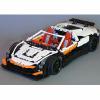Sign in to follow this
Followers
0

How flexible are your cars?
By
Lipko, in LEGO Technic, Mindstorms, Model Team and Scale Modeling
-
Recently Browsing 0 members
No registered users viewing this page.
